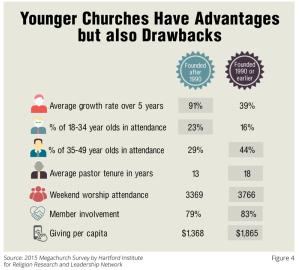While there are more participants in megachurch worship than ever before, individual attendance is declining, indicates a new study released by Dallas-based Leadership Network this month. For purposes of the study, the basic qualifier of "megachurch" equaled a congregation of 2,000 people in weekend attendance.
"Last weekend, 1 in 10 adults and children who went to a Protestant church went to a megachurch — about 5 million people," said Warren Bird, co-author of the study released Dec. 2 and director of research for Leadership Network.
Bird, along with researcher Scott Thumma, director of the Hartford Institute for Religion Research, constructed an 18-page report about the study, including infographic and 24 illustrations. The title is, "Recent Shifts in America's Largest Churches: Megachurches 2015 Report." They said individual attendance of those going to megachurches is down to once or twice a month, or less.
"They think 'regular attendance' is 'I get there when I can,'" Thumma stated in a Religion News Service article.
"We found many of these large, successful congregations still have many of the same challenges of smaller congregations. They are not immune to the cultural dynamics in society. Everyone is trying to attract new people and hold on to them and make them disciples. But, today, people are seekers and shoppers looking for a temporary experience of worship, not a long-term commitment."
Three major patterns were cited in the new study:
- Trends in becoming multisite (one church in two or more locations)
- Significant amount of large churches that sponsor an internship or residency program
- Decrease in median seating capacity of megachurch's main sanctuary

Megachurches, many of which were started decades ago by Baby Boomers, are starting to have declining attendance in younger generations. Participation by Millennials, ages 18 to 34, has flattened out at about 19 percent since 2010. But Gen-X attendees, ages 35 to 49, are down from 28 percent in 2010 to 23 percent today.
The study found megachurches established since 1990 are growing at more than double the rate of older megachurches. However the study, which was funded by the Beck Group, a company that builds megachurches, found the new churches are constructed very differently. Congregations are "getting bigger by getting smaller," said Bird. They're building smaller main sanctuaries (median down from 1,500 seats to 1,200 seats) but holding more services on more campuses.
Five years ago, 46 percent of megachurches had multiple locations. Now it's 62 percent. The number of sites also increased from an average of 2.5 sites to 3.5.
Older megachurch congregations have a more diverse age range, higher member involvement in programming and $500 more in per capita giving than the big churches founded since 1990, the study indicated.

Survey respondents for this study were senior pastors or executive staff of congregations. They indicated a shift in how religious self-image now are being described. Every year since Bird and Thumma started studying megachurches in 2000, the percentage that describe themselves as "evangelical" has increased. Now, it's 71 percent, no matter what their denomination, said Bird.
An estimated 40 percent of megachurches are nondenominational. "God and Rick Warren know Saddleback Church is Southern Baptist," said Bird, but most people who worship there don't in the RNS article.
More important to representative congregants now is service to others outside their own congregations.
Thumma said that "for a very long time, the focus of megachurch programming was inward - taking care of our own people. Now there's a huge shift to outreach: 43 percent said global missions were a specialty of their congregations, and 44 percent said one of their specialties was community service and helping those in need."
Bird said worshippers care "about finding a church that knows where it's going and what it's about. They like clarity of vision in a church."







